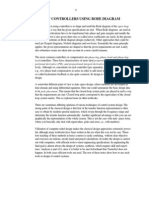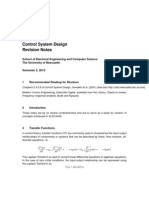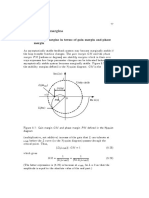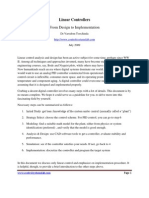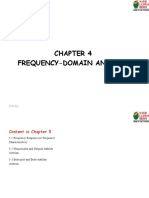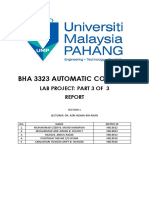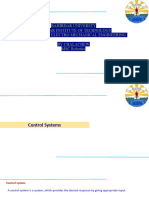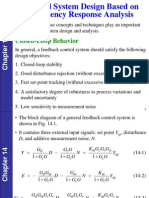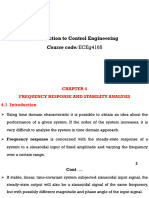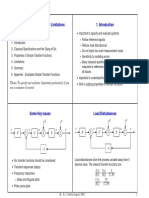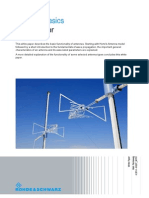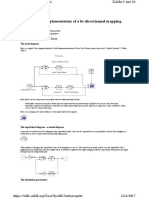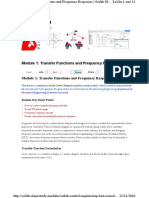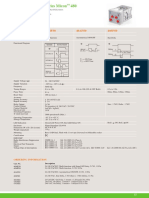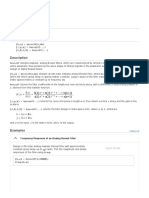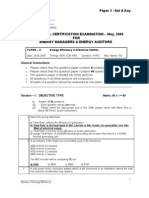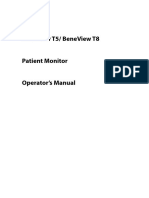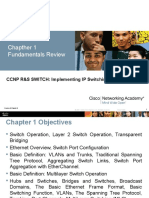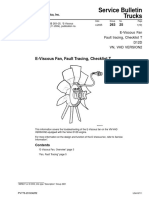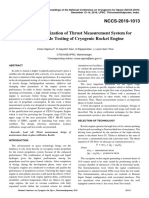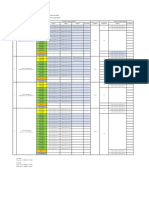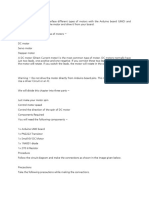Module 3: Classical Loopshaping Design | Scilab Ninja
1 12
Scilab Ninja
Control Engineering with Scilab
Module 3: Classical Loopshaping Design
Tweet
Like
Share
Share
Module 3: Classical Loopshaping Design
This article is contained in Scilab Control Engineering Basics study module, which is used as course material
for International Undergraduate Program in Electrical-Mechanical Manufacturing Engineering, Department of
Mechanical Engineering, Kasetsart University.
Module Key Study Points
Understand the tradeoffs in feedback control design
Learn how to formulate design specs as bounds on frequency responses
Relationships between open-loop and closed-loop frequency responses
Perform basic frequency response shaping of loop transfer function
Recall from module 2, we define 3 important transfer functions
Loop :
(1)
Sensitivity :
(2)
Complementary Sensitivity :
(3)
that become the key players, especially for an approach of feedback control design commonly known as
classical control, since it originated from the 40 during WWII. This study module focuses on such
http://scilab.ninja/study-modules/scilab-control-engineering-basics/mod... 11/11/2016
Module 3: Classical Loopshaping Design | Scilab Ninja
2 12
approach. In essence, we will perform frequency response shaping on the loop transfer function
to
yield the desired control specifications, often referred to as loopshaping*.
* We have to make a remark though, that this term is also used in some modern design scheme to shape the
closed-loop frequency responses directly. In this module we focus on shaping the open-loop transfer function
.
Before getting into the design procedure, we need to formulate the stability and performance requirements
from last module to a general SISO feedback diagram with exogenous signals injected at various points in the
loop, as shown in Figure 1.
Figure 1 a general SISO feedback diagram
Performance Criteria
The following closed-loop responses can be easily derived
(4)
(5)
(6)
Together with the plant, the transfer functions that play the roles in these expressions are the sensitivity
and complementary sensitivity
. Note that these two closed-loop transfer functions are functions of the
controller, so design criteria can be casted on them.
For example, good tracking performance requires that
approaches zero. From (5), it implies that
should be made small. Now, suppose that measurement noise
want this unwanted signal to affect the plant output
that
is prevalent in this system. We do not
. From (4), this noise rejection requirement implies
should be made small. So, we must design a controller to yield small
and
. But this
requirement violates the algebraic constraint
(7)
i.e., when
approaches 0,
goes to 1, and vice versa. This conflict suggests that some tradeoffs
have to be made in the control design specifications.
Fortunately, in normal situation the exogenous signals entering the feedback loop in Figure 1 have different
frequency spectrum that could ease off the problem considerably. We summarize them as follows:
http://scilab.ninja/study-modules/scilab-control-engineering-basics/mod... 11/11/2016
Module 3: Classical Loopshaping Design | Scilab Ninja
3 12
(command input): common command signal is smooth and varies gradually with time, so it naturally lies
in low-frequency region.
(disturbance): a typical disturbance signal entering at the input or output of the plant also has lowfrequency spectrum, such as mechanical vibration, resonance, or in the robot joint case, the dynamic force
exerting from adjacent links.
(measurement noise): most sensors become noisy when frequency increases. So the measurement noise
generally lies in high-frequency region.
This allows us to cast frequency-dependent specifications to
represent them as magnitude of frequency responses
can make
and
and
. It is more convenient to
. So, in the above situation, we
small in low frequency region (for good tracking), and
small in high frequency
region (noise rejection).
Stability Criteria
Note: in the discussion that follows, we assume a stable, minimum-phase plant, such as the DC motor robot
joint used as our example. Some statements may not be valid for an unstable or non-minimum phase plant.
Stability requirement for classical control design can be explained clearly using relationship between the
magnitude of sensitivity
distance from
and Nyquist plot of
as shown in Figure 2. It can be shown that the
curve to the critical point -1 is inversely proportional to
. The shorter this
distance, the poorer stability margin of the system. The circle in Figure 2 represents the magnitude
. Hence, when
, the curve of
is inside the circle. As a result, control
design spec for stability can be made as a bound on the peak of sensitivity frequency response. Note that this
peak occurs at some mid frequency region before
converges to 1 and
roll-off.
Figure 2 relationship between sensitivity frequency response and Nyquist plot
http://scilab.ninja/study-modules/scilab-control-engineering-basics/mod... 11/11/2016
Module 3: Classical Loopshaping Design | Scilab Ninja
4 12
Design Criteria Imposed on Loop Transfer Function
In some postmodern control strategy such as
synthesis, the stability and performance bounds discussed
above can be formulated into weighting functions on
and
directly. That strategy is also called
loopshaping (on closed-loop transfer functions). For the classical control design scheme, however, the
frequency response shaping is performed on the loop transfer function
converted to bounds on
. Hence, all the criteria must be
To summarize the stability and performance criteria on the closed-loop transfer functions, we separate them to
3 frequency regions LOW, MID, and HIGH. From the above discussion, we have the following design specs
LOW:
for good tracking and disturbance attenuation
MID: since
indicates poor stability. An upper bound on
the algebraic constraint that
HIGH:
implies
for measurement noise rejection performance.
Now, these closed-loop bounds can be converted to constraints on
LOW: for small
is needed. Note from
by using these relationships
, we have
; i.e., the bound on
. Hence
is created by inverting the bound on
MID: By means of Figure 2, the bound on
implies
is translated to stability margins criteria on
non-minimum phase plant, Bode gain-phase relationship is normally used in shaping
. For a stable,
in MID
frequency to have sufficient phase margin. More on this later.
HIGH: for small
, we have
; i.e., the bound on
. Hence
is the same as the bound on
implies
This can be summarized in Figure 3 and 4.
http://scilab.ninja/study-modules/scilab-control-engineering-basics/mod... 11/11/2016
Module 3: Classical Loopshaping Design | Scilab Ninja
Figure 3 bounds on
5 12
and
Figure 4 bounds on
Bode Gain-Phase Relationship
The stability requirement on
in Figure 4 may need more explanation. Suppose there is no stability
requirement in terms of phase margin, we could make the magnitude of L to have its slope as steep as we
want to easily satisfy both the low and high frequency bounds. Such simplicity is not feasible due to a
constraint at the crossover frequency known as the Bode gain-phase relationship, which states that
For a stable, minimum-phase system, the phase of any transfer function
has a unique relationship
with its magnitude. On a log-log plot, if the slope of magnitude plot has a constant slope n over a decade of
frequency, then
(8)
This suggests a basic rule for stability of classical control design. For the closed loop system to have
sufficient phase margin, within some frequency region around crossover, the slope of
must be
approximately -1, or -20 dB/decade. This is depicted in Figure 4. may have higher slope in low and high
frequency regions to satisfy the performance bounds, but at crossover it should try to maintain -20 dB/decade
for some frequency band.
Now I hope the reader could grab the concept. No better way to understand classical control design than
experimenting with a problem set.
http://scilab.ninja/study-modules/scilab-control-engineering-basics/mod... 11/11/2016
Module 3: Classical Loopshaping Design | Scilab Ninja
6 12
Example: let us design a controller for our same old robot joint driven by DC motor developed since the first
module
(9)
with the following design specs
1. steady state error is eliminated
2. low frequency disturbance is attenuated at least 0.01 below 1 Hz
3. high frequency measurement noise is attenuated 0.1 above 100 Hz
4. closed-loop stable, with phase margin at least 40 degrees
From the above discussion, this can be translated to stability and performance bounds
1.
has an integrator. Note that
already has one
2.
below 1 Hz
3.
above 100 Hz
4.
has at least 40 degrees phase margin, or
* Problem 1 asks you to derive this relationship
To aid this design problem, we write a specific script file lshape.sce. Download this file and open it with
SciNote. The variables for design specs 2 4 are initialized at the top of file, which you could later change to
modify the bounds to your own specs. Right now we stick with the given values.
Lets see how this script works. From module 2, we design a lead-lag compensator
(10)
that yields closed-loop stability and quite good tracking performance. This controller is the default when you
first download the script. So we start our experiment with it. Run the script from Scilab command prompt
-->exec('lshape.sce',-1)
to observe the frequency responses versus bounds in Figure 5 and 6. Loopshaping procedure uses Figure 5 as
a tool to design a controller, while Figure 6 is used to demonstrate the relationship between the frequency
responses and bounds from open-loop and closed-loop systems.
http://scilab.ninja/study-modules/scilab-control-engineering-basics/mod... 11/11/2016
Module 3: Classical Loopshaping Design | Scilab Ninja
Figure 5 plot of
Figure 6
and
7 12
versus bounds from lshape.sce
versus bounds from lshape.sce
Notice from Figure 5 that, the lead-lag compensator (9) does not meet the low-frequency requirement. The
curve of
must be above the 40 dB line shown in magenta for all frequency less than 1 Hz. The text
http://scilab.ninja/study-modules/scilab-control-engineering-basics/mod... 11/11/2016
Module 3: Classical Loopshaping Design | Scilab Ninja
in legend for LF bound also shows (violated!). As a result, the
8 12
curve in Figure 6 violates its LF
bound, where it should be below the -40 dB level for all frequency less than 1 Hz.
So we need to design a new controller, obviously with more LF gain and higher bandwidth, to meet the specs.
To demonstrate the Bode gain-phase relationship, lets do something crazy by choosing a controller with only
proportional gain of 60000. Figure 7 shows the resulting
, with its magnitude curve above the LF
bound and below the HF bound as desired. Checking the phase margin, however, we see that the system now
has zero phase margin. The magnitude of
(and
) in Figure 8 also violates the stability bound. Can you
explain what happens?
Go back to the Bode gain-phase relationship statement. This static gain controller results in the slope of
equals -40 dB/decade at crossover frequency. So its phase is -180 degree; i.e., no phase margin left.
Simulate this system to verify that the step response should oscillate indefinitely.
Figure 7 plot of
versus bounds with static gain
http://scilab.ninja/study-modules/scilab-control-engineering-basics/mod... 11/11/2016
Module 3: Classical Loopshaping Design | Scilab Ninja
Figure 8
and
9 12
versus bounds with static gain
So, to design a controller that meets all specs, the curve of
must be above the LF bound, pass the
crossover at slope -20 dB/decade (and maintain this slope for as wide frequency range as possible to achieve
enough phase margin), and roll off below the HF bound.
We recommend that the reader should first try shaping the loop by his/her own controller to understand the
concept. If you dont succeed or your patience run out, lshape.sce comes with a sample controller
(11)
Uncomment the lines that create this controller, and run the script to see Figure 9 and 10. The responses
versus all stability and performance bounds confirm that this controller meets all the specs. The system has
phase margin equal 55 degrees. The bandwidth is about 25 Hz.
http://scilab.ninja/study-modules/scilab-control-engineering-basics/mod... 11/11/2016
Module 3: Classical Loopshaping Design | Scilab Ninja
Figure 9 plot of
Figure 10
and
10 12
versus bounds from controller (10)
versus bounds from controller (10)
Use the Xcos model lshapesim.zcos in Figure 11 to simulate time-domain responses. What we want to verify
in particular is design specs no 2 and 3; i.e., disturbance and measurement noise attenuation. The disturbance
and measurement noise signals are set to
and
, respectively.
http://scilab.ninja/study-modules/scilab-control-engineering-basics/mod... 11/11/2016
Module 3: Classical Loopshaping Design | Scilab Ninja
11 12
Figure 11 lshapesim.zcos Xcos model for time-domain response simulation
So with disturbance attenuation of 0.01 and noise attenuation of 0.1, both signals should make the output
oscillates at magnitude 0.1. Figure 12 and 13 confirms that both the specs are met.
Figure 12 disturbance attenuation response of controller (12)
http://scilab.ninja/study-modules/scilab-control-engineering-basics/mod... 11/11/2016
Module 3: Classical Loopshaping Design | Scilab Ninja
12 12
Figure 13 measurement noise attenuation response of controller (12)
Problems
1. Show that the relationship between phase margin
and the maximum peak of
is given by
2. Use lshape.sce to design a controller to achieve disturbance attenuation performance of 0.001 (-60 dB).
Other specs remain the same.
3. Design a controller to achieve disturbance attenuation of 0.01 (-40 dB) for frequency below 10 Hz. Other
specs remain the same. Explain if you are unable to get a controller that meets these requirements.
Supplement
Control design using Bode plots MIT OpenCourseWare
Scilab tips: we have not discussed some commands in the CACSD group that may be helpful, such as
g_margin and p_margin , which are quite convenient for computing gain and phase margins, respectively.
Read Scilab help for usage of such commands.
Scilab/files used in this module
lshape.sce Scilab script file for loopshaping design
lshapesim.zcos Xcos model file for time-domain simulation
module3.zip : all Scilab and Xcos files used in this module.
http://scilab.ninja/study-modules/scilab-control-engineering-basics/mod... 11/11/2016












